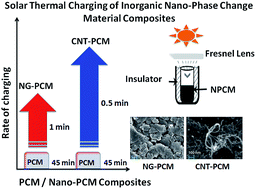Ultrafast thermal charging of inorganic nano-phase change material composites for solar thermal energy storage
Abstract
The present research article reports the heat transfer characteristics of nano-phase change material (NPCM) composites: nanographite (NG)–PCM composites and multi-walled carbon nanotube (CNT)–PCM composites. For the preparation of NPCM composites, inorganic PCM, magnesium nitrate hexahydrate (Mg(NO3)2·6H2O) was used as the pristine PCM and nanocellulose was used as a stabilizing agent. NG–PCM composites were prepared by varying the concentration of NG from 0.1–0.6 wt%, whereas CNT–PCM composites were prepared using 0.1 and 0.2 wt% of CNT. The prepared NPCM composites exhibited enhanced thermal conductivity and a faster heating rate than pristine PCMs. Two different experimental setups were used for investigating the heat transfer characteristics of the prepared NPCM composites during the melting and solidification processes: (i) conventional heating and (ii) solar illumination. The experimental observations indicated a higher heat transfer rate in the NPCM composites as compared to pristine PCM for both experimental setups. It was observed that the heating melting and solidification rate using a conventional heating setup increased by 48% and 77%, respectively, for NG–PCM composites (at 0.6 wt%) & 24% and 15%, respectively for CNT–PCM composites (at 0.2 wt%). Upon solar illumination, both NG–PCM and CNT–PCM composites demonstrated an ultrafast heating rate (of the order of few seconds) and a higher heating temperature than the conventional heating based approach. The ultrafast heating of NPCM composites upon solar illumination was attributed to the plasmonic heating effect of carbon nanomaterials, which instantly convert optical energy into heat at nanometer scale in addition to conventional thermal diffusion based slow heating, the sole mechanism responsible for slow heating of PCM composites in a conventional heating setup. Out of the two carbon nanofillers used, CNTs were shown to have a better heat transfer performance than NGs to collect, convert and store the broad spectrum solar energy as thermal energy.


 Please wait while we load your content...
Please wait while we load your content...